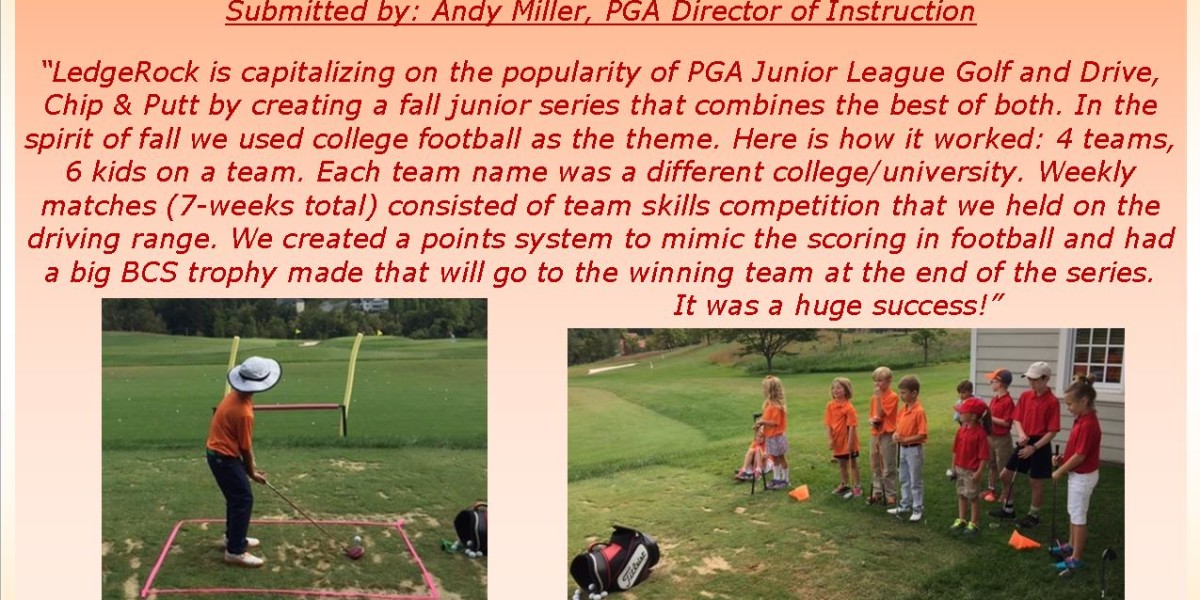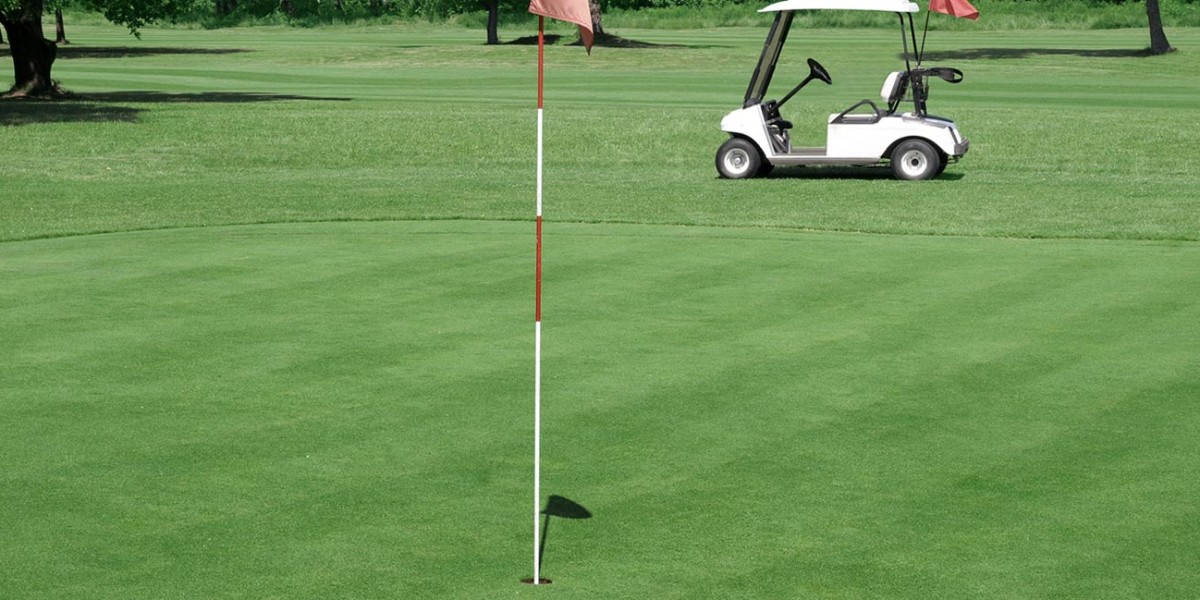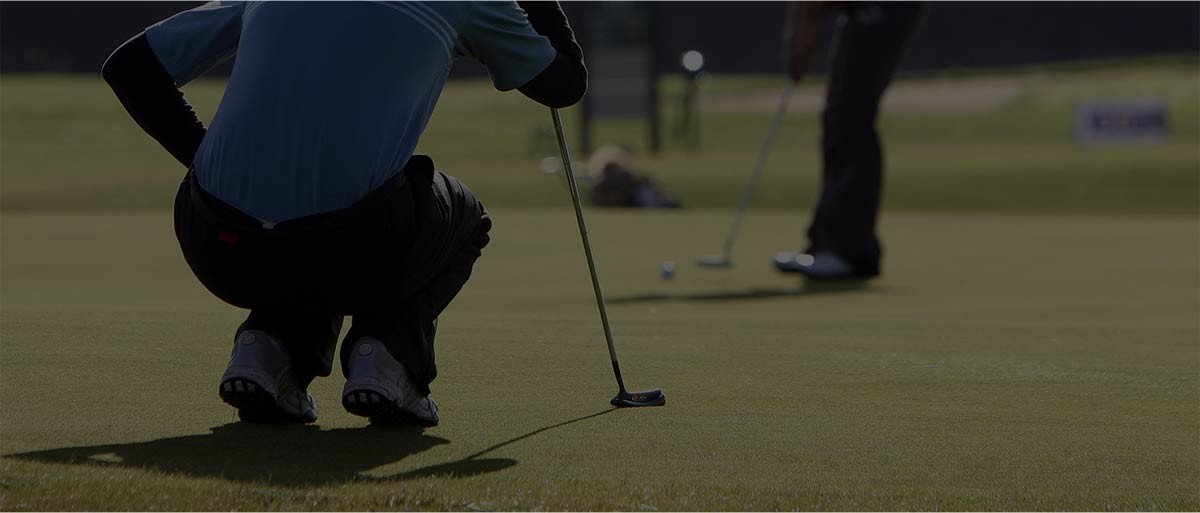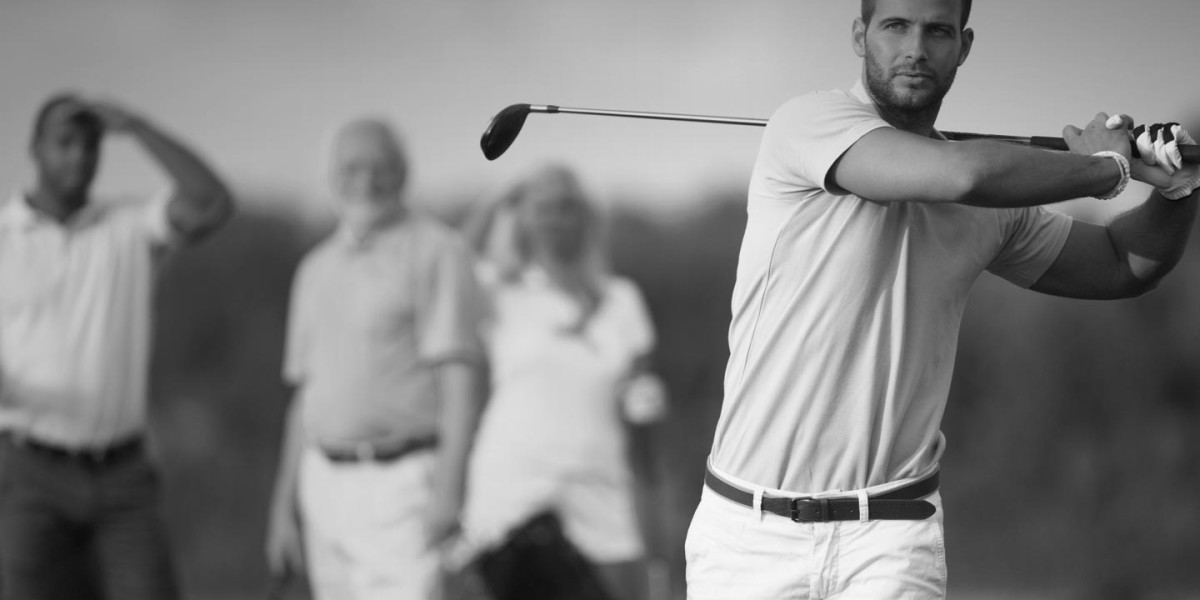Month: February 2016
Mental Game
Mike Dynda, PGA – Blue Bell Country Club
Enjoy the Challenge!!!!!!!!!
Blue Bell Country Club
2005 Philadelphia Section PGA Teacher of the Year
www.bluebellcc.com
Practice
Bob Thatcher, PGA – Olde Masters Golf Club
Keeping students interested and taking more lessons.
In order to keep and maintain a constant flow of lessons the instructor must provide enthusiasm for the student and their progress. He must show genuine understanding for their unique problems in the learning process. Student feedback is required for a team effort approach to be effective. Keep track of each student’s progress from day one. Give them a “strategy for improvement” road map so they have an idea of where they are going and how you can plan to help them get there. Establish realistic goals both long and short term. Getting them to buy into the idea of setting aside time to practice may be the most important item for their ultimate success.
In order to keep my students coming back I have instituted several stratagem that have proved effective:
- I offer a buy six lessons and pay for five package
- I offer a practice ball plan that encourages the students to practice.
- I always work around the green for sand, chipping, putting and other greenside areas as a positive reinforcing of the scoring aspect of the game.
- Using video enhances the process and shows the student that you are able to offer the needed training tools to make them better.
- I have a tickler file on all students to follow up on their progress even in the off season via email and phone if needed.
- I have each student called in early spring in order to get them back in the swing of golf by promoting fresher lessons.
Bunker
“The Sand Shot” – Bob Thatcher, PGA – Olde Master’s Golf Club
The basic sand shot requires rhythm, timing, balance, and proper technique. It is broken down in three main areas: address, takeaway and downswing/follow through.
Address:
- Open stance aimed well left of the intended target – approximately 10 to 15 degrees. The hips should be slightly open.
- The ball is played at the left instep.
- Weight is placed toward the left foot- distributions about 65/35.
- The club face is open aiming along the intended target line.
- Anchor feet to prevent slipping.
- Hands are forward of the ball.
Takeaway:
- The club is taken back along the intended target line (on an inside path).
- The hands hinge or cock early.
- You must take a fall, evenly paced, backswing.
- Your head and eyes must remain over the ball. Your eyes focused on the spot just behind the ball.
- No appreciable weight shift should take place.
- At the top of the swing, your hands should be relaxed and motionless – ready for the downswing.
Downswing:
- Your weight should be toward the left foot.
- Hands and arm should be relaxed.
- A sensation of your hands falling or pulling should be felt. This pulling should be along the foot line thus allowing the open club face to slide under and across the ball.
- Remain focused on the spot of impact just behind the ball (1 to 2 inches)
- Try to maintain an even tempo.
- Permit the body to turn and face the target in an even and flowing manner. (Do no help the club) (7) This even movement of the body to the ball should help to eliminate deceleration.
This secret of good sand play is sound technique, good instruction, lots of practice, and a real desire to improve. Should you need more help I suggest you contact your local PGA Professional.
Compliments of Bob Thatcher and Staff at Olde Masters Golf Club.
Short Game
Tip 1 – Vin Ciarlone, PGA – Northampton Valley Country Club
Here are some of the tips I taught while working with the John Jacobs
Golf Schools in Scottsdale,Arizona.SHORT GAME
- Check your lie
- See the shot in your mind
- Choose a club
- Try a couple swings
- Play the correct shot
Chipping
Grip as you would in the full swing
Bottom edge of club perpendicular to the intended line
Deloft the club by moving the end of the grip one to two inches
forward, toward your intended line
Move your body to the end of the grip (Ball now located near your
back foot. Keep a narrow stance.
Most of your weight on your forward side (Closest to target) (It
provides a steeper attack)
Keep your wrists firm throughout the swing
Swing the club back to your pocket, keep your hands ahead of the
club face (That will produce a low flying shot) and continue your swing to
your other pocket
Club selection will determine the length your chip will roll on
the ground. Less lofted clubs will travel farther. The pace of the swing
will determine the length the ball will fly through the air.
Tip 2 – Adrienne Hogan, PGA – Medford Village Country Club
Swing
Swing
Tip 1 – Charlie Ralapaugh, PGA – White Deer G.C.
The dreaded banana ball or slice. The unwanted, unwelcome shot pattern that haunts 90% of all golfers starting the game. A shot that starts well left of your target then curves sharply to the far right of your target. Cure your banana ball using the following tips.
-
Use a stronger grip. Turn both hands to the right on the grip or handle until both V’s formed by your thumbs and first fingers point to your right shoulder. At this point you should see two and a half knuckles on your left hand.
-
Close up your stance by pulling your right foot and shoulder back 3 or 4 inches. Move the ball back a few inches in your stance. Keep the club face square or slightly closed to your target.
-
As your swinging into the ball feel like your right hand is rolling over your left hand and your right forearm is rolling over your left forearm, closing the face of your club through impact.
-
Your arms should be extended into a straight position during impact.
-
Practice these tips before going on the course to get rid of your BANANA BALL.
Tip 2 – Craig Dear, PGA
Everyone has a problem, at times, with maintaining the hands on the club throughout the swing. It seems that piccolo playing with our grip at the top of the backswing afflicts us all. A physiological reason for this to happen is the inherent weakness of the left thumb and its inability to hold the club at the transition from backswing to throughswing. The thumb does not have the inherent strength to hold the club at the top without support from the right hand. When the right hand comes off the left thumb, it (the thumb) feels the stress and since the hand is a unit, the fingers at the end of the club loosen and take the uncomfortable pressure off the thumb. When the hand loosens, the club moves and when the hand reflexively tightens through the ball the club head is turned to the left causing an annoying little hook. The solution is simple: keep the left thumb supported with the right palm and your grip will stay intact.
Holding the finish seems to be one of the hardest things to do for many golfers, they want to return to the address position with a recoil or fall in the direction of least resistance. We have all seen it and we have also all done it. Somehow it isn’t completely logical for something we do after the ball is gone to have a significant effect on the result. There are three very good reasons to hold the finish and “pose”. First, because our finish position is one of balance, the actual position is a very specific and repeatable one. If we finish a couple of inches out of balance we start to fall down, so if we maintain our balance, the position is the same every time and one of the inescapable truths is that if we start from the same beginning place and end up the same ending place every time the path between has a better chance of being the same. Second, If we go to an ending position which completes the motion, we are much more Likely to finish all the things we have to do to hit the ball successfully. Third, every tempo, to be consistent must have a defined beginning and a defined end. The fact that every measure of music has the same number of beats allows the musician who is playing the piece to know exactly where his note belongs. (all right, conventional music) If we want a consistent rhythm we have to define the beginning and the end. The beginning is easy, the end can be tricky if we don’t associate it with a defined position. Hold the ending position and all these things happen pretty much automatically.
When I was a young golfer, (first 18 hole round 53 years ago) conventional teaching stated that you hit the ball in nearly address position. There was a junior tourney clinic where I heard a professional state that the address position is so important because it is the same position you hit the ball from. My father, also a PGA member told me to look at the impact photos of the best players before I decided to try it. It really surprised me to see every one of the great players right knee past the center of his head at impact. That was 50 years ago, and another change has happened. The majority of the great Players (not all but nearly all) have the outside edge of the left shoulder behind the ball at impact and still having the right knee past the center of the head at impact. It truly changes how we teach players how to hit the Driver. (unless you like to argue with success)
Tip 3 – John Dunigan, PGA Master Professional – Hartefeld National GC
Make better contact and improve your consistency and distance.
The pros take a divot after the ball. Of course, you know that already. Did you know that, on average, the deepest part of the divot, which we should call “low point,” occurs between 4 and 5 inches after the ball? That’s a very big deal. Here’s a quick little drill that will allow you to move your low point forward in a very short amount of time. With no ball, address the ground–you’ll need grass to do this and please don’t do it on a golf course!!! Take a divot with a full 7 iron swing. Now, without moving your feet, hit the front of that divot with your next swing. Then hit the front of that divot on the next swing. You will be moving your low point even more forward with each successive swing. The close you get the low point to 4 inches ahead, the better ball striker you will become.
Remember the goal is to hit the ball into the ground, not into the air, and NOT hit the ground into the ball. Let the loft of the club combined with the backspin produced by downward contact get the ball into the air for you.
Good Luck! John
www.johndunigan.com
Impact
By Rick Flagler
PGA Director of Instruction
Bala Golf Club
In this tip I want to focus on impact. Obviously, there are many important things that can be focused on during the golf swing. Grip, stance, posture, swing plane, shoulder plane, body rotation and the list goes on. With my students I like to focus on proper ball/turf contact and the position the body and hands should be in to achieve solid impact.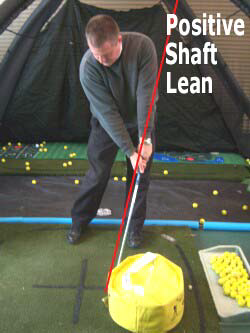
To achieve solid impact you have to have what I refer to as Positive Shaft Lean. PSL can really only be achieved by allowing the hands to lead the club head into the golf ball. This allows you to have the proper ball turf contact or “trappin
g of the ball” that we all strive for. Most problems usually surface when people don’t allow their hands to lead long enough in the swing before they strike the ball. In essence they release the club too soon and they achieve Negative Shaft Lean. NSL is where the club head has been allowed to pass or flip past the hands before impact and this leads to poor and inconsistent ball striking.
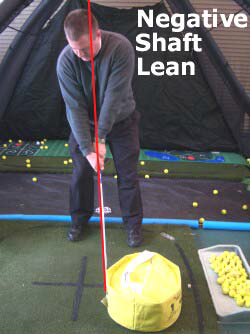
A great training aid to use to get the proper feed back you are looking for is an impact bag. The impact bag has been around for a long time and there is a reason for it. They are simple and effective which is a nice combination. To get started, use a six or a seven iron and place the back of the bag in the middle of your stance. Make some smooth swings, about half speed, and take note of where the club head is in relation to your hands at impact. If you do it properly you should have Positive Shaft Lean which means your hands will be slightly ahead of the club head at impact.
We can focus on the proper position of the body at another time.
If you have questions on this or anything else, please let me know. Play well,
Rick Flagler
PGA Director of Instruction Bala Golf Club
267-664-3789
Thinking is Succeeding
By Mark Sheftic
PGA Director of Instruction
Merion Golf Club
For over twenty years in the golf field, I have competed, taught and attended many professional seminars that examined the golf swing, short game, and course management. Now as I progress in my teaching career, a common question is frequently asked of me. “What is the key to the golf swing?” Following this complex question my students want to know, is there a magical move that will take me to the next level?
My answer to this significant question is always the same and catches most by surprise. “The key to a great golf swing takes place before you grip the club!”
Without a player consciously knowing this, he or she determines the success of the shot before the ball is in flight. This illustrates one of my favorite statements, “A player hits the desired shot or misses the desired shot before he or she swings the club.” This declares the importance of mental preparation.
Ones mind is the 15th club that completes the golf bag. The six inches between your ears is the most powerful tool or most destructive piece of equipment we carry. This brings me to the main point of this article, “The most important part of a golf shot are the decisions you make prior to hitting the ball!”
Here is a checklist of questions that need to be considered to determine the type of shot to play:
- How is the lie?
- What are the conditions of the wind?
- Where is the pin?
- How far do I need this ball to travel?
- Is the putt up hill or down hill?
After one evaluates these questions and answers, then …
“PUT YOUR ATTENTION INTO YOUR INTENTION”
Here are visual examples that model a pre-shot routine that utilizes strong mental preparation.
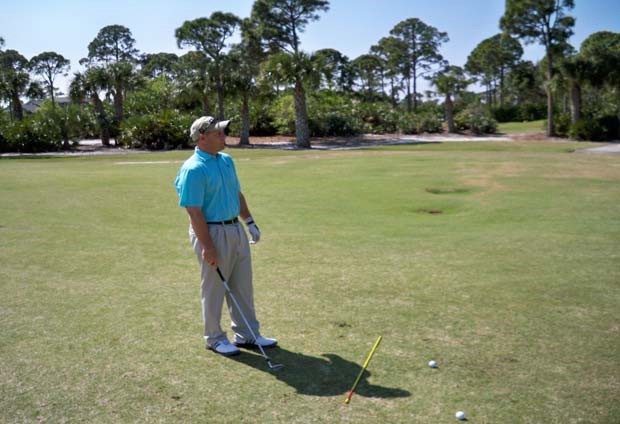
- Start behind the ball analyzing the shot at hand. Figure out the highest percentage shot to play. Stand behind the ball and go through the mental checklist that will lead to a clear and decisive decision.
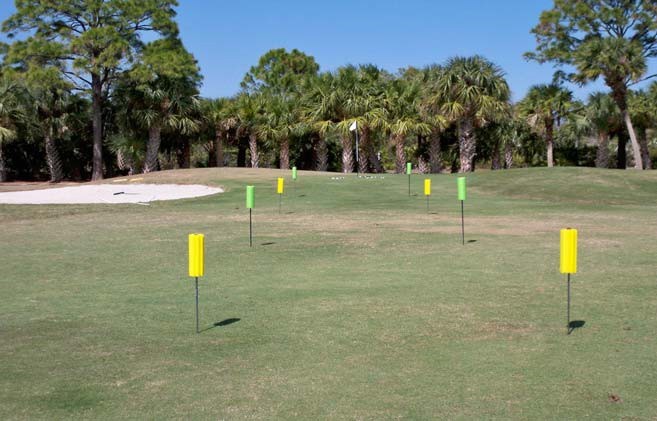
- Create a picture or a visual image. The stronger the image, the more focused and committed one becomes. This is an example of a clear, narrow path leading up to the pin.
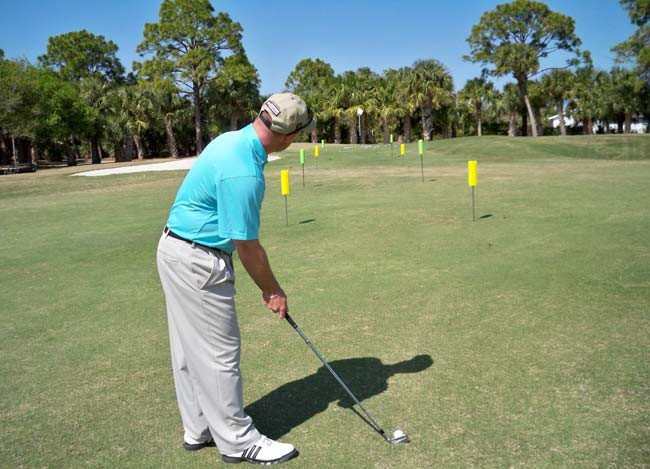
- Carefully work into the ball making sure alignment is perfect. Notice the clubface and the attention to the target.
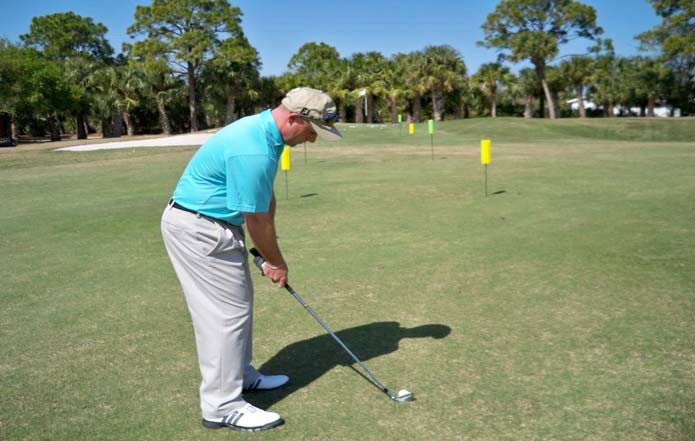
- Complete the set up.
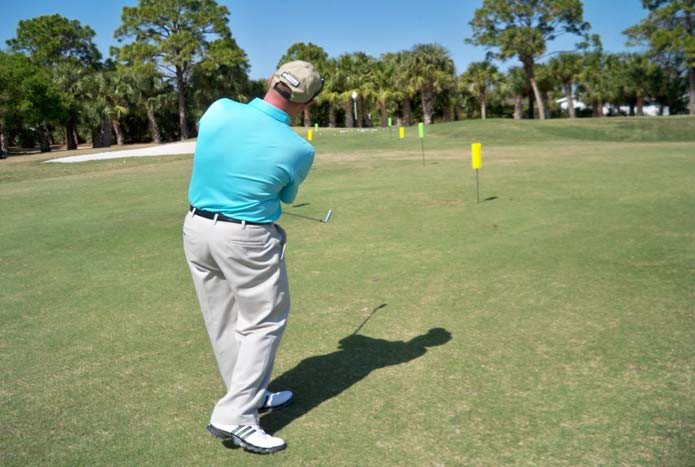
- Without wasting time, execute the shot. Keep the focus clear and mental image on the desired outcome.
Creating the right mental attitude and building a strong mental foundation, is more important than hitting the club. It takes practice and determination to strengthen the mind and utilize it to our fullest.
Mark Sheftic
Director of Instruction
Merion Golf Club

